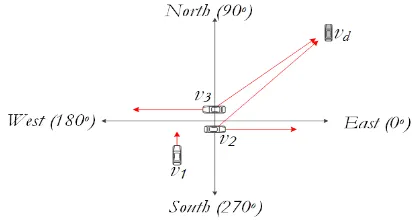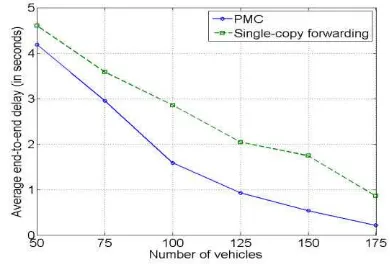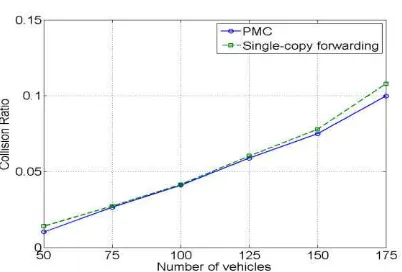vehicular ad hoc network
Article in Journal of Engineering and Applied Sciences · March 2016
READS
2
2 authors, including:
Nazrulazhar Bahaman
Technical University of Malaysia Malacca
37PUBLICATIONS 28CITATIONS
SEE PROFILE
PROACTIVE MULTI-COPY ROUTING PROTOCOL FOR URBAN
VEHICULAR AD HOC NETWORK
Aslinda Hassan and Nazrulazhar Bahaman
Faculty of Information and Communication Technology, Universiti Teknikal Malaysia Melaka, Hang Tuah Jaya, Durian Tunggal, Melaka, Malaysia
E-Mail: [email protected]
ABSTRACT
A vehicular network topology is very dynamic compared to traditional mobile ad hoc network because of the movement and speed of the vehicles. Thus, a vehicular network is always partitioned due to this reason, especially if the vehicle density is low. In this situation where a direct end-to-end path between source and destination can be considered as non-existent, a regular ad hoc routing protocol with complete path discovery mechanism is not feasible since the routing path is usually disconnected due to the intermittent nature of network links. To overcome this problem, vehicles can be used as carriers to deliver messages using store-and-carry forwarding whenever forwarding option via wireless transmission is not available. It has been ascertained by the majority of researches in VANET that the carry and forward procedure can significantly affect an end-to-end delivery delay. This paper focuses on developing a proactive multi-copy routing protocol with carry and forward mechanism that is able to deliver packets from a source vehicle to a destination vehicle at a small delivery delay. The paper emphases on replicating data packets and distribute them to different relays. The proposed protocol creates enough diversity to reach the destination vehicle with a small end-to-end delivery delay while keeping low routing overhead by routing multiple copies independently. The simulation results in an urban grid model show that the proposed multi-copy forwarding protocol is able to deliver packets at small delivery delay compared to a single-copy forwarding algorithm without having to rely on real time traffic data or flooding mechanism.
Keywords: routing protocol, carry and forward, vehicular, vanet.
INTRODUCTION
In general, a vehicular ad hoc network (VANET) is formed between nodes an as-needed basis. To create a VANET, vehicles need to have wireless transceivers and computerized modules that enable the vehicles to act as network nodes. Similar to mobile ad hoc networks (MANET), VANETs consist of radio-enabled vehicles which act as mobile nodes and routers for other nodes. Although VANETs share a few common MANETs characteristics such as organization and self-management, short radio transmission range and limited bandwidth, they also have significant features that differentiate them from other types of ad hoc networks [1], [2]. common for the forwarding path to go over some areas of the network where the number of vehicles is low and a next forwarding vehicle is hard to find. In this situation, an end-to-end connection over a large distance may not always exist. To support data dissemination in the presence of partitioned or disconnected networks, a carry and forward approach is used where a forwarding vehicles carries the data packet when a suitable next hop vehicle is not available, and forward the packet when a new vehicle moves into its vicinity. Basically, packets are stored and carried temporarily in a moving vehicle while waiting for opportunities to forward them via wireless channel. Although this approach can increase the chance of
delivering the data packet to its destination, it can influence the packet's end-to-end delivery delay since the packet is moving with the speed of the carrying vehicle as opposed to the speed of light. Majority of VANET routing protocols is now designed to include a store-carry and forward feature as part of their recovery method. Some examples that use this feature are Vehicle-Assisted Data Delivery (VADD) protocol [4], Greedy Traffic-Aware Routing (GyTAR) protocol [5], and Border Node based Routing (BBR) protocol [6].
In this paper, we design and implement a routing protocol with a carry and forward feature that is able to deliver data packets with small end-to-end delay without the use of real time traffic data to determine forwarding path, or flooding mechanism. The underlying idea of our protocol design is to forward multiple copies of data packets at road intersections to increase the chance of reaching the destination, and thus reduce the end-to-end delivery delay.
RELATED WORKS
shortest path especially, if the geographically shortest path contains partitioned networks, and packets have to be carried by vehicles instead of transmitted via wireless channel. At each intersection, GyTAR dynamically selects the next candidate junction by taking real-time vehicular traffic into account. However, choosing forwarding path with high density paths may not be the optimal solutions in minimizing delivery delay. If all vehicles have the same idea in using high density paths, channel utilizations along these paths will increase, and as a result, packets may either get dropped or incur higher delays
The Distributed Vehicular Broadcast (DV-CAST) [7] and the Border Node based Routing (BBR) [6] protocols use restricted flooding mechanism to deliver packets to the destination vehicles. DV-CAST suppress Positioning System (GPS) device.
In addition, we are assuming the source vehicle acquires the location of the destination vehicle via a location service, which is beyond the scope of our design and will be not discussed in this paper. Once the destination vehicle's location is obtained, the information is carried in the packet so that intermediate nodes do not have to use the location service. However, due to the dynamic nature of a vehicular network, the destination node may have already left the area by the time packets arrive at the initial location. In this case, the packet carrier will obtain the new location of the destination node via a location service and forward the packets toward the new location. Further, we presume the use of a location service is limited only to acquiring the destination node location. Therefore, each vehicle in the network will depend on the beaconing system for its neighbour’s information.
Proactive Multi-Copy (PMC) protocol design
The PMC protocol is based on the idea of a carry and forward protocol combining with a single hop beaconing system. In the PMC protocol, packet replication is made only at the intersection in which multiple road paths to the destination are available based on the candidates moving direction and destination vehicle positioning information. At the straight road section where there is no alternative paths, the protocol greedily forwards packets to the next intersection that leads towards the destination.
In this protocol, we assume that each node maintains neighbourhood state information in an nb_table,
which stores the id, the time of the beacon transmission, the current position, the speed, and the velocity of the neighbouring vehicles at the time when the beacon is received. This information is acquired through single-hop beaconing system, where a vehicle would broadcast its information to its single-hop neighbours.
As shown in Figure-1, there are three packets modes in the PMC protocol; greedy forwarding mode, multi-copy forwarding mode, and recovery mode. When a vehicle receives a packet, and the destination vehicle is one of its current neighbour, it immediately transmits the packet to the receiver. Otherwise, the vehicle will determine whether it is located at an intersection or not (intersection_radius). If the vehicle is currently at an intersection, the packet enters the multi-copy forwarding mode. Otherwise, it enters the greedy forwarding mode. In the greedy forwarding mode, the packet carrier finds the best next hop (nexth) via the greedy algorithm with direction awareness. This algorithm will be explained later in this section. In either multi-copy forwarding mode or greedy forwarding mode, if the current vehicle is unable to find the closest node to the destination node other than itself, or also known as local maxima, the packets then enter the recovery mode.
Figure-1. Transition modes in PMC protocol
This situation is commonly happened in a sparse network, where a vehicle may not have any information on its neighbours at all or the neighbours already left its transmission range. In the recovery mode, packets are carried in the buffer and the carrying vehicle will try to retransmit once it receives beacons from its neighbour or when it arrives within other vehicle's transmission range.
Figure-2. Example scenario for multi-copy forwarding at determine whether or not a data packets has already been replicated and forwarded beforehand in a particular intersection.
In Figure-2, after v1 receives a data packet n (DPktn) from vs at intersection I1, it verifies whether or not
DPktn has been replicated and forwarded at I1 previously. If DPktn has been replicated at I1 before, v1 drops DPktn. Otherwise, v1 implements multi-copy forwarding, by examining of each road segment at I1 to find out which of the four directions are moving toward vd. In the example scenario, road segment I13 with Northbound direction and
I13 with Eastbound direction which are greyed out in the Figure-2, are the best road segment candidates for packet replication. Henceforth, using greedy algorithm with direction awareness, v1 finds the next hop from its neighbouring vehicles for the selected road segments and forwards the packets to the selected next hop vehicles, which in the example v2 and v3. After v1 replicates DPktn and forwards to v2 and v3, both v2 and v3 forward DPktn to road segments r12 and r13, respectively via greedy forwarding with direction awareness. After forwarding packets to v2 and v3, v1 stores DPktn, vd and I1 information in the m_copy table. This process is then repeated once
DPktn reaches intersections I2 and I3.
Majority of forwarding algorithms in VANET have ascertained that greedy forwarding is not enough to current vehicle is moving towards the destination vehicle. However, relying exclusively on θ in Equation (1) is not enough to determine whether vk is moving towards or away from vd. The current forwarder also needs to discover the cardinal direction of a candidate vehicle, vk, before calculating θ. Figure-3 displays an example scenario why discovering cardinal direction of a vehicle candidate is important for directive awareness. Each cardinal direction shown in Figure-3 is assigned with an angle of the polar coordinate system; North = 90o, South = 270o, East = 0o, and West = 180o.
Figure-3. Example scenario for directive awareness algorithm.
[10] to generate realistic vehicle mobility with maximum speed of 15 m/s. Using this model, each vehicle is able to adjust its speed based on the movement of the neighbouring vehicles and change lane to overtake other vehicles in multi-lane roads. This model also supports smart intersection management, where vehicles slow down and stop at intersections, or they act accordingly at traffic lights. Table-1 summarizes the configuration parameters used in the simulation. The communication range is set at 250 meters and all vehicles are required to broadcast beacon packets every 0.5 second. Five pairs of source and destination vehicles are selected in random and each source transmits one data packet for every two seconds.
Figure-4. Manhattan grid topology used in the simulation.
Table-1. Network model configuration.
The PMC protocol uses a single-hop beaconing system to acquire knowledge on local topology. However, we design the PMC protocol with a fixed beaconing system since the routing overhead is not the research focus in this paper [11].
Performance metrics
For each scenario, we execute our simulation with 100 iterations to ensure statistical validity for 95% confidence interval. The performance assessment is based on four metrics:
1. Packet delivery ratio: Measures the fraction of data packets that are successfully received by destination to those generated by traffic source.
2. Average end-to-end delay: Measures the average
difference between the time a data packet is originated
by an application and the time the same packet arrives at its destination.
3. Routing overhead ratio: Measures the fraction of total beacon packets emitted to total number packets transmitted in the network.
4. Total collision ratio: Measure the ratio of total number of collisions to total number of packets transmitted in the network
SIMULATION RESULTS AND ANALYSIS
Figure-5 to 8 presents the simulation results on performance comparison between the PMC protocol and the single-copy forwarding algorithm.
Figure-5. Simulation result on average end-to-end delay (in seconds).
Figure-6. Simulation result packet delivery ratio.
Figure-8. Simulation result on collision ratio.
Figure-7 and 8 display the comparison overhead and collision ratios between PMC and single-copy forwarding in the simulation, respectively. In the figures, PMC and single-copy forwarding show similar overhead and collision ratios while achieving lower end-to-end delay. Even though the number of vehicles increases in a dense network, the PMC protocol is still able to maintain similar overhead ratios as single-copy forwarding since PMC uses the same beaconing system as single-copy forwarding with only small additional bytes of information added to the beacon packet.
CONCLUSIONS
In this paper, we presented a new proactive multi-copy (PMC) routing protocol that reduces end-to-end delay by proactively replicates data packets at intersections and forwards them to different intermediate nodes. By forwarding multiple copies of packets to different relays at different road segments, the protocol increases the chance of reaching the destination at low delivery delay. The forwarding mechanism is based on information that is commonly available via a GPS device. Simulation in an urban grid model has shown that the PMC protocol is able to reduce the average end-to-end delay and increase the delivery ratio compared to single-copy forwarding results. Despite having additional information added to beacon packets to minimize redundant replication, the results have shown that the proposed protocol is able to maintain similar overhead and collision ratios as the single-copy forwarding algorithm
ACKNOWLEDGEMENTS
The authors would like to thank INSFORNET Research Group of Universiti Teknikal Malaysia Melaka (UTeM) for the financial support under the university Short Term Grant with Project No. PJP/2014/FTMK(1B)/S01295
REFERENCES
[1] H. Hartenstein and K. Laberteaux. 2010. VANET: vehicular applications and inter-networking technologies. Wiley Online Library. p. 3341.
[2] S. Al-Sultan, M. M. Al-Doori, A. H. Al-Bayatti, and H. Zedan. 2014. A comprehensive survey on vehicular Ad Hoc network. J. Netw. Comput. Appl., 37(1): 380-392.
[3] G. Karagiannis, O. Altintas, E. Ekici, G. Heijenk, B. Jarupan, K. Lin, and T. Weil. 2011. Vehicular Networking: A Survey and Tutorial on Requirements, Architectures, Challenges, Standards and Solutions. IEEE Commun. Surv. Tutorials. 13: 584-616.
[4] J. Zhao and G. Cao. 2008. VADD: Vehicle-Assisted Data Delivery in Vehicular Ad Hoc Networks. Vehicular Technology, IEEE Transactions on. 57(3): 1910-1922.
[5] M. Jerbi, S.-M. Senouci, T. Rasheed, and Y. Ghamri-Doudane. 2009. Towards Efficient Geographic Routing in Urban Vehicular Networks. IEEE Trans. Veh. Technology. p. 58.
[6] M. Zhang and R. Wolff. 2008. Routing protocols for vehicular Ad Hoc networks in rural areas. IEEE Commun. Mag. 46(11): 126-131.
[7] O. K. Tonguz, N. Wisitpongphan, and F. B. F. Bai. 2010. DV-CAST: A distributed vehicular broadcast protocol for vehicular ad hoc networks. IEEE Wirel. Commun. 17: 47-57.
[8] T. Issariyakul and E. Hossain. 2008. Introduction to Network Simulator NS2 1st ed. Springer Publishing Company, Incorporated.
[9] The Network Simulator NS-2.
[10] J. Harri, M. Fiore, F. Filali, and C. Bonnet. 2009. Vehicular mobility simulation with VanetMobiSim. Simulation. 87: 275-300.



